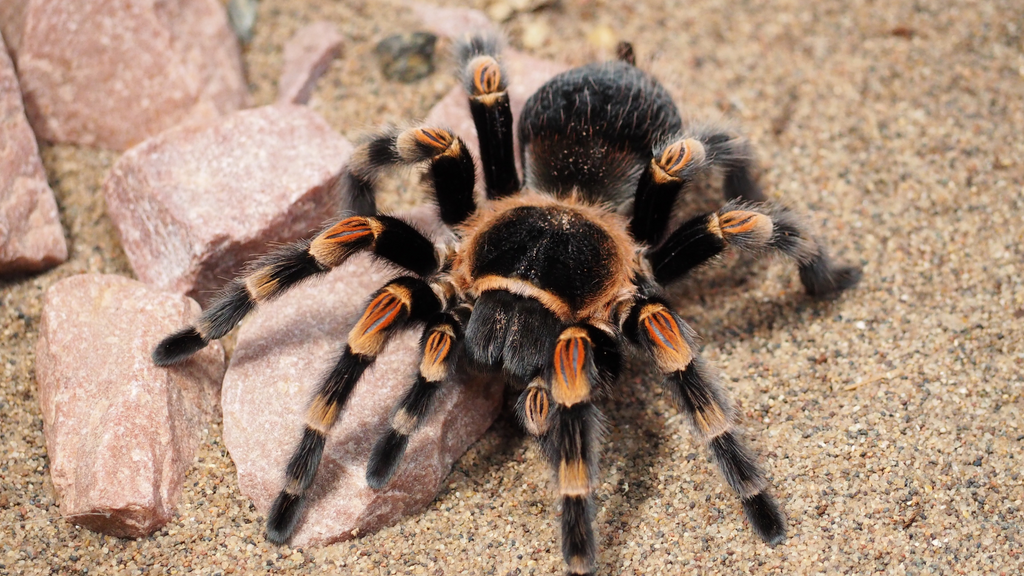Mexican Red Knee Tarantula (Brachypelma hamorii) Caresheet and Bioactive Guide

Mexican Red Knee Tarantula (Brachypelma hamorii) Caresheet and Bioactive Guide
Difficulty: Beginner. With their beautiful coloration, gentle nature, and manageable care needs, the Mexican Red Knee Tarantula is a fantastic species for beginner and experienced tarantula keepers alike.
The Mexican Red Knee Tarantula Brachypelma hamorii (formerly B. smithi) is undoubtedly one of the most iconic and well-loved species in the hobby. With its striking black and orange coloration, this tarantula has captured the imagination of arachnid enthusiasts and casual viewers alike, thanks to its appearances in movies like Indiana Jones and Star Trek: The Next Generation. Classified intially as Brachypelma smithi, this species was reclassified as Brachypelma hamorii following further studies into its subtle differences from other species.
Native to the dry forests, savannas, and scrublands of western Mexico, this species thrives in an arid-leaning environment. Mexican Red Knee Tarantulas are not known for extensive webbing behavior. They primarily use silk to line their burrows and create molting mats, rather than producing large web structures. In their natural habitat, these tarantulas construct silk-lined burrows under vegetation like cacti, utilizing the silk to detect vibrations from passing prey. The diagonal leg span (DLS) of this species is 5.5” (14 cm), and this slower-growing tarantula can live for decades—females can live up to 25-30 years and males 7-10 years.
Despite being widely available in the hobby, Brachypelma hamorii faced serious population declines due to overcollection for the pet trade and local extermination practices. Thankfully, it was listed on CITES in 1985, helping to prevent further declines.
Habitat Requirements for the Mexican Red Knee Tarantula:
Spiderlings & Juveniles:
For young tarantulas, I recommend starting with a Tarantula Cribs spiderling enclosure or a similar-sized enclosure (ideally one that is about 3”x3”x3”). You want an enclosure that provides ample space for growth, plenty of depth for burrowing, cross ventilation, and is easy to maintain. Fill the enclosure halfway with Terra Aranea substrate, which is a bedding for tarantulas that holds burrows well and maintains humidity without getting soggy. Keep the substrate slightly moist for spiderlings, as they need a bit of humidity while they're still small. Include a hide, and ensure the enclosure has plenty of depth for burrowing—an essential part of their natural behavior. Provide a small water dish and mist the enclosure or drip water along the sides every couple of weeks. Make sure the water dish is replenished regularly, and that the substrate remains dry.
As your tarantula matures, you can transition it into a Bio Dude Acrylic Display Box Medium or similar sized enclosure.
What You Need for a Bioactive Adult Mexican Red Knee Tarantula Enclosure:
-
10 gallon aquarium
-
Terra Aranea Substrate kit which includes Terra Aranea bioactive substrate, biodegradables like leaf litter, sphagnum moss, and soil inoculant BioShot
-
Bio Dude Solar Grow LED for plant lighting
-
The Bio Dude rock water bowl shallow water dish
Or, you can use the complete species-specific bioactive vivarium kit for Mexican Red Knee Tarantulas.
For adults, I recommend using the Bio Dude Acrylic Display Box Large or similarly sized enclosure. This species will not need more than a 10-gallon aquarium or an equivalently sized acrylic enclosure. These enclosures are spacious enough to allow the tarantula to roam and exhibit natural behaviors while also keeping them safe. Fill the bottom of the enclosure with Terra Aranea substrate to a depth of at least 4 inches to allow for burrowing and support plants. Elephant feed, pepperomia cuttings, and small succulents are good options for flora. The enclosure should also have a hide, a water dish, and enough room for the tarantula to move freely.
Temperature/Humidity Requirements
Temperature: 68-78°F (20-25°C) is optimal. Nearly all species of tarantula do well at average room temperatures. Of course, their natural environment may have daytime temperatures in the 80’s or 90’s, but remember that during these times, tarantulas are hidden away in their burrows underground where it is much cooler. Then they venture out at sunset when temperatures are not nearly as warm as during the day. Typically the temperature of a tarantula burrow is not much different than the temperatures we find comfortable in our homes. A stable temperature is key, and the best way to achieve this is by adjusting the room’s ambient temperature. Heat mats and lights are not recommended as they can lead to stress and even injury.
Humidity: Aim for low to moderate humidity levels between 40-50%. This species does well in a drier environment and can suffer if kept too moist. This is a fairly forgiving species and will do better in a drier environment than in a more humid environment. Remember—these spiders are not tropical, but they also are not a desert species. Usually, the ambient humidity of your house is ideal unless you live in a desert. It is important to take into consideration what time of year it is. Your home may be at a comfortable 40% or 50% humidity level the majority of the year, but in the winter when the furnace starts running, it will dry out fast. So be extra vigilant when the heat is on to keep the water dish filled and one side of the enclosure a little damp. Alternatively, if you live in a naturally humid place, increasing the amount of ventilation in the enclosure can help bring levels down.
Dietary Requirements
Watering: Ensure your tarantula has access to fresh water at all times. Place a shallow water dish in the enclosure, and refill it regularly. I recommend misting the sides of the enclosure with water every couple of weeks, but don’t over-saturate the substrate—keep it dry with just enough moisture to maintain humidity.
Feeding: Feed your Mexican Red Knee Tarantula appropriately sized prey based on its life stage. The amount and frequency should be based on the size of your tarantula’s abdomen. If their abdomen (back) is smaller than the width of their carapace (head area), they should be fed more often. If their abdomen is wider than their carapace, they should be fed less often. Here is a general guideline for a feeding schedule, but the amount and frequency should be adjusted based on the abdomen size:
-
Spiderlings: Feed small prey like pinhead crickets or small roaches about once or twice a week. Always remove uneaten prey within 24 hours.
-
Juveniles: As they grow, feed them 1-2 small to small or medium crickets weekly, depending on their size. I reduce the frequency as the tarantula matures. Always remove uneaten prey within 24 hours.
-
Adults: Feed adult tarantulas 6-8 large crickets, or a couple of large Dubia roaches, every 3-4 weeks. If your tarantula refuses food, don’t worry—it's normal for this species to fast for extended periods. Always remove uneaten prey within 24 hours.
It is important to note that you NEVER need to dust your feeders when feeding tarantulas. Tarantulas and their supplies may be commonly sold alongside reptiles, but they are not the same and neither is their care (though there are some similarities). There is even some anecdotal evidence and strong beliefs on the internet that using calcium supplement dust on tarantula feeders can be harmful and lead to issues with molting. The best way to ensure your tarantula is getting all the necessary vitamins and minerals from their prey is to gutload the feeders. Provide the crickets or roaches with some fresh fruit and vegetables 24 hours before feeding them to your spider. Some leafy greens, carrots, oranges, apples, or any produce you have rotting in the vegetable drawer of your fridge will work great!
Handling & Temperament
The Mexican Red Knee Tarantula is generally docile and does well in captivity, but handling is not advised. These tarantulas are known to be "hair kickers," and their urticating hairs can cause irritation or even swelling, especially for those sensitive to them. There is always the risk that your tarantula might bite you, but you usually have plenty of warning beforehand. If a tarantula is annoyed, it will usually rear up its front two legs in a threat posture. When this happens, your tarantula is warning you that if you continue doing what you are doing, it might try and bite you to get you to stop. If you just leave the tarantula alone, it will calm down. In the extreme case that you were to get bitten, the Mexican Red Knee tarantula does not have medically significant venom and the pain from the fangs would be worse than any envenomation. The only real risk would be a rare allergic reaction that led to anaphylaxis.
If you do handle your tarantula, it should be done carefully and only if absolutely necessary. The risk of any harm is more for the tarantula than the handler. Tarantulas do not like being held and will sometimes try to bolt away suddenly to escape their keeper's grasp. Since tarantulas do not have great eyesight, they will blindly bolt off the sides of tables or right out of your hands and fall 3 or 4 feet to the floor. Any drop of more than a few inches for a terrestrial tarantula can cause an abdomen rupture which is almost always fatal. So if you do handle your tarantula, it is advised that it be done over a table or while sitting on the floor. Always use caution when interacting with this species to avoid stressing them out or causing injury.

Final Thoughts
With their beautiful coloration, gentle nature, and manageable care needs, the Mexican Red Knee Tarantula is a fantastic species for beginner and experienced tarantula keepers alike. By setting up a proper enclosure, maintaining the right temperature and humidity, and feeding appropriately, you’ll be well on your way to keeping a thriving Brachypelma hamorii. Remember, patience and attention to detail are key to making sure your tarantula is happy and healthy.
Written by Richard Stewart of Tarantula Collective 3/4/2025
Relevant Videos:
- Josh Halter










